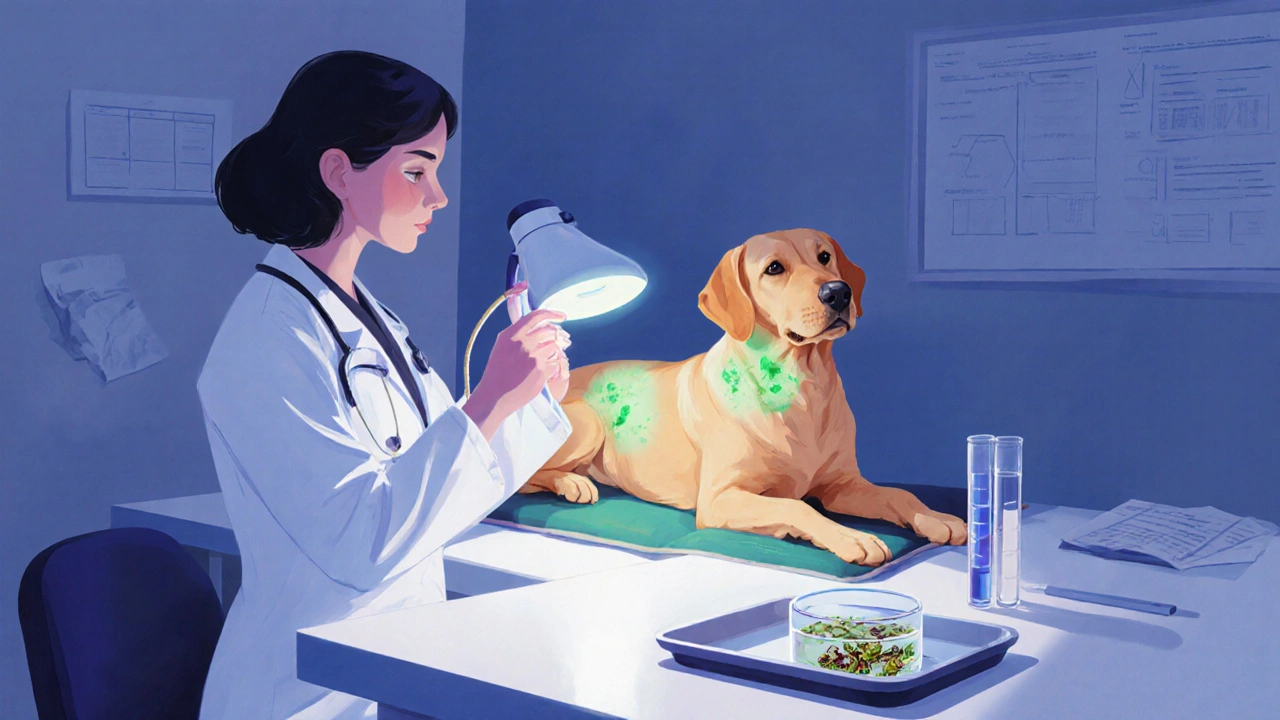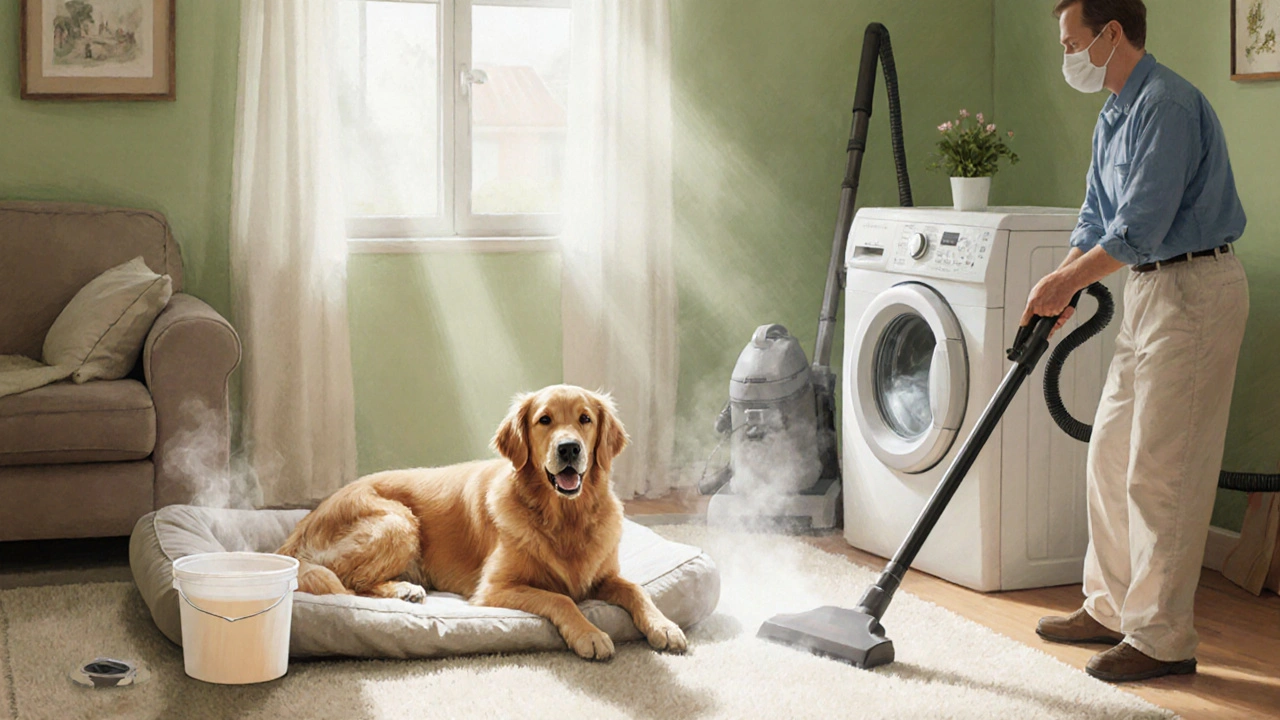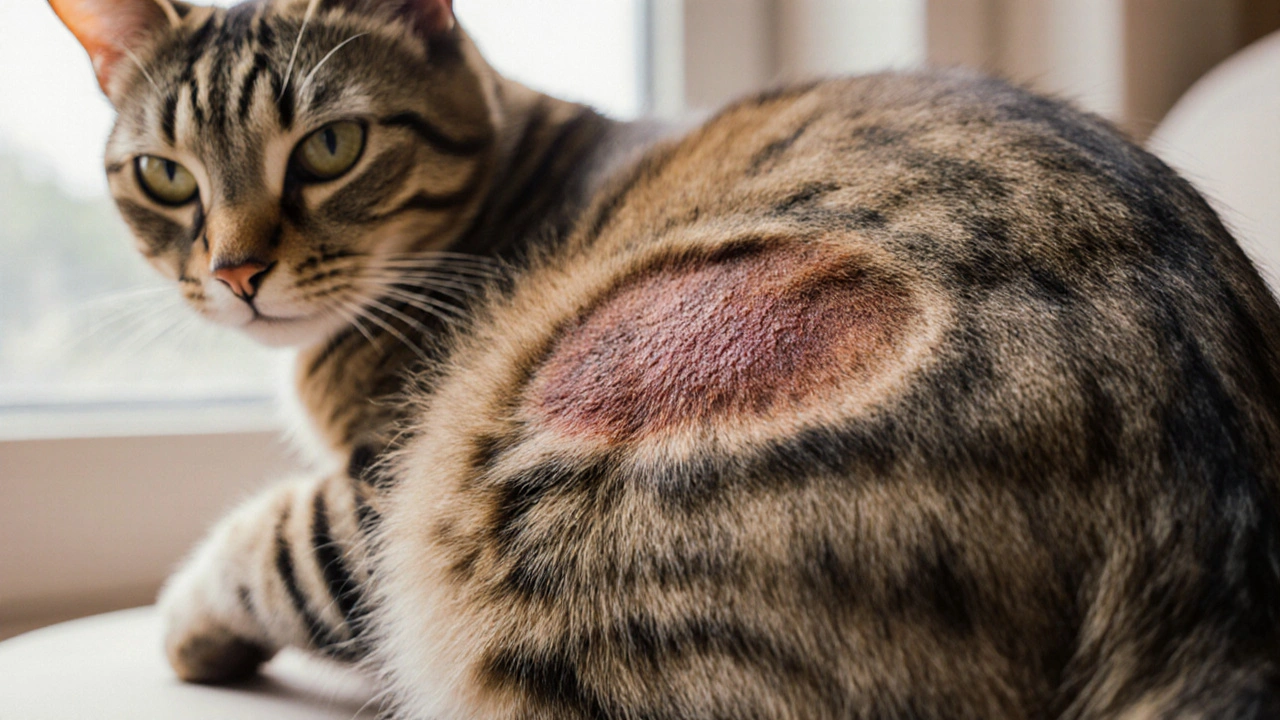Ringworm Treatment Duration Calculator
Treatment Estimator
Estimate your pet's ringworm treatment duration based on infection severity and chosen method.
Key Takeaways
- Ringworm is a fungal skin infection that spreads easily between animals and people.
- Look for circular, scaly patches and hair loss on your pet’s skin.
- Veterinarians diagnose it with a Wood’s lamp, fungal culture, or skin scraping.
- Topical creams work for mild cases; oral antifungals are needed for extensive infections.
- Regular cleaning, avoiding shared grooming tools, and prompt treatment keep your furry friend healthy.
What Exactly Is Ringworm?
When people hear "ringworm" they picture a worm, but it’s actually a Ringworm is a contagious skin infection caused by dermatophyte fungi that feed on keratin in hair, skin, and nails. The infection shows up as red, circular patches that may look scaly or crusty. It affects cats, dogs, rabbits, and even exotic pets, and it can jump to humans, making it a shared household concern.
How Do Pets Catch It?
Ringworm spreads when spores land on a pet’s skin or fur. The most common culprits are Microsporum canis, a zoophilic fungus that loves cats and dogs, and Trichophyton mentagrophytes, which often jumps from rodents or the environment to pets. Spores survive for months on furniture, bedding, and grooming tools, so a single infected animal can seed an entire home.
High‑traffic areas, shelters, grooming salons, and veterinary clinics are hotspots. Young animals with under‑developed immune systems are especially vulnerable.

Spotting the Signs Early
Ringworm doesn’t always make your pet itch. Typical clues include:
- Circular patches of hair loss, often with a raised border.
- Redness or scaling around the patch.
- Fine, powdery crust that looks like dust.
- In severe cases, thickened skin or secondary bacterial infection.
If you notice any of these, start a focused exam. Early detection shortens treatment time and reduces the chance of spreading the infection.
How Vets Diagnose Ringworm
A Veterinary dermatologist examines the animal, uses a Wood’s lamp (UV light) to highlight fluorescence, and often takes skin scrapings for fungal culture. The culture confirms the exact species, which helps choose the most effective antifungal. In a busy clinic, a rapid PCR test can deliver results within a day, but traditional culture remains the gold standard for accuracy.
Treatment Options: What Works Best?
Treatment hinges on the infection’s extent, the animal’s health, and owner preferences. Below is a quick comparison of the two main approaches.
| Aspect | Topical Treatment | Oral Medication |
|---|---|---|
| Typical Use | Localized patches, mild to moderate infection | Extensive or deep‑rooted infection, multiple lesions |
| Common Products | miconazole cream, clotrimazole spray | itraconazole tablets, fluconazole capsules |
| Duration | 2-4 weeks, twice‑daily application | 4-6 weeks, once‑daily oral dose |
| Side Effects | Rare skin irritation | Possible liver enzyme elevation, gastrointestinal upset |
| Cost | Low to moderate | Higher, especially if long‑term |
In practice, vets often start with topical therapy and add oral medication if the infection doesn’t shrink after ten days. Monitoring liver function through blood work is standard when using oral antifungals.

Home Care & Environmental Decontamination
Even after the pet clears up, spores can linger in the house for months. Effective Environmental decontamination involves vacuuming, washing bedding at 60°C, and using a diluted bleach solution (1:32) on hard surfaces. Steam cleaners are a pet‑safe alternative for carpets and upholstery.
Discard any grooming tools that can’t be thoroughly disinfected. If you use a shared scratching post, replace it or give it a good soak.
Prevention: Keeping Ringworm at Bay
There’s no vaccine for ringworm, so prevention leans on hygiene and early detection:
- Regularly brush your pet to spot hair loss early.
- Wash hands after handling stray animals or after cleaning litter boxes.
- Avoid letting pets roam in communal areas without recent health checks.
- Quarantine new pets for at least three weeks and run a Wood’s lamp exam before they join the household.
- Use a pet‑friendly antifungal spray on high‑risk areas (e.g., kennels) during outbreaks.
These steps cut the chance of a spore‑filled home, especially in multi‑pet families.
When to Call the Vet Right Away
If you notice any of these red flags, pick up the phone:
- Rapid spread of lesions over a few days.
- Signs of pain, swelling, or pus.
- Loss of appetite or lethargy accompanying skin changes.
- Any skin infection in a newborn puppy or kitten.
Prompt professional care prevents deep tissue involvement and reduces the risk of the infection jumping to humans.
Frequently Asked Questions
Can ringworm be cured without medication?
Mild cases sometimes clear on their own if the pet’s immune system is strong and the environment is kept spore‑free. However, most veterinarians recommend at least topical antifungal treatment to speed recovery and minimize spread.
Is ringworm contagious to humans?
Yes. The fungi can infect human skin, especially on the hands, feet, and scalp. Good hygiene-washing hands after handling pets and avoiding direct contact with lesions-keeps people safe.
How long does treatment usually last?
Topical therapies typically run for 2‑4 weeks, while oral antifungals may require 4‑6 weeks. The vet will repeat a Wood’s lamp exam or culture after treatment to confirm clearance.
Can I use over‑the‑counter creams on my pet?
Human antifungal creams can be safe for short‑term use, but it’s best to follow a vet‑prescribed product. Dosage, potency, and application frequency differ between species.
What cleaning products are effective against ringworm spores?
A diluted bleach solution (1 part bleach to 32 parts water) works on hard surfaces. For fabrics, washing at 60°C or using a commercial fungicidal laundry additive eliminates most spores.





Macy Weaver
I've been watching a few folks struggle with the environmental cleaning part of ringworm care. The bleach solution can really make a difference, but you have to be consistent. I like to vacuum daily and then mop with the diluted bleach on hard floors. Also, washing the pet's bedding at 60 °C twice a week cuts down spore load dramatically.
Keeping an eye on any new hair loss patches helps you catch a flare early.
James McCracken
All this fuss over fungi is just a modern obsession.
Evelyn XCII
Honestly, the whole "Ringworm is not a worm" thing is a bit overkill, but okay. I guess the spores survive longer than my patience for cleaning. If you forget to scrub the cat tower, expect a repeat performance. Anyway, good luck with the vet visits.
Suzanne Podany
Hey everyone, just wanted to add that regular brushing is a simple way to spot those tiny patches before they spread. A quick check after playtime can save weeks of treatment. And remember, a clean environment benefits all pets in the house.
Steve Moody
When approaching the management of dermatophytic infections in companion animals, one must first establish a clear differential diagnosis, as misidentification can lead to suboptimal therapeutic regimens.
The article correctly highlights Wood's lamp examination, yet it neglects to emphasize the variable fluorescence among Microsporum species, which can confound clinicians.
Moreover, fungal culture remains the gold standard; rapid PCR is useful, but its sensitivity varies with sample quality.
Topical agents such as miconazole and clotrimazole are efficacious for localized lesions, but their penetration depth is limited, necessitating oral antifungals like itraconazole for extensive disease.
Oral therapy, while potent, carries hepatotoxicity risks; baseline and periodic liver enzyme monitoring is non‑negotiable.
The recommended treatment durations in the calculator are reasonable, yet practitioners should tailor them to the host's immune competence and lesion chronicity.
Environmental decontamination is often underappreciated; spores persist on upholstery for months, so steam cleaning or high‑temperature laundering is indispensable.
Bleach solutions (1:32) are effective on non‑porous surfaces, but the vapour can be irritating to sensitive pets, requiring adequate ventilation.
In multi‑pet households, quarantine protocols for newly introduced animals should extend beyond the typical three‑week window, especially when sourced from shelters.
Vaccination against ringworm does not exist; thus, hygiene remains the cornerstone of prophylaxis.
The article's preventive checklist is solid, yet adding routine fungal screenings in high‑risk kennels would bolster early detection.
Consider also the psychosocial impact on owners; recurring infections can erode the human‑animal bond, so clear communication is essential.
Finally, note that while humans can become infected, zoonotic transmission is uncommon when proper hand hygiene is observed.
In summary, a multimodal approach-diagnostic precision, targeted pharmacotherapy, rigorous environmental sanitation, and owner education-constitutes best practice for ringworm management.
Dave Barnes
Yo Steve, that was a marathon of info, but u nailed the core points. I’d add that some owners find over‑the‑counter shampoos helpful as a bridge before getting a prescription.
Just make sure they’re vet‑approved for pets.
Kai Röder
Indeed, supplementary topical measures can augment systemic therapy, particularly in cases with stubborn plaques.
Continuous monitoring ensures optimal outcomes.
Ashley Helton
Great rundown, but honestly, most people just want the quick fix.
If the cream works, why bother with all the lab work?
Just get the pet on something and call it a day.
Alex Mitchell
Hey folks! 🙋♂️ I’ve been using a pet‑safe antifungal spray on my dog’s crate and it’s made a huge difference.
Just spray weekly and wipe down the surfaces after a few minutes.
It’s a simple step that keeps spores at bay.
Amanda Jennings
Stay motivated, pet parents! It’s easy to feel overwhelmed, but each day of consistent care brings you closer to a clean home.
Celebrate tiny wins-like a patch that stops spreading.
alex cristobal roque
Alright, let’s break this down in plain speak. First, you’ve got a fungal infection that loves keratin, so it hangs out on fur, skin, and nails. The good news? We have creams and pills that actually kill the fungus, but you’ve got to apply them consistently. Topical stuff works best when the infection is limited to a few spots; you’ll need to rub in the cream twice a day and keep the area clean. If you skip doses, the fungus can rebound faster than you think. Oral meds, like itraconazole, go system‑wide and are necessary when the infection spreads or hits harder‑to‑reach places. Those pills can mess with the liver, so a vet will likely run blood work before and during treatment. The article’s calculator is handy, but think of it as a rough guide, not a decree. Environmental cleaning is a huge piece of the puzzle-spores love to hide in carpet fibers and bedding. Vacuum often, wash everything that can go in the washer at a hot temperature, and consider a diluted bleach mop for tile floors. Steam cleaners are also pet‑friendly and can kill spores without chemicals. Quarantine any new animals for at least three weeks and give them a quick skin check before they mingle. Remember, ringworm can jump to humans, especially kids and immunocompromised folks, so wash your hands after handling the pet or cleaning its space. If you see the infection spreading fast, call the vet immediately-delays can lead to deeper tissue involvement. Finally, keep your pet’s overall health strong with good nutrition; a robust immune system can help clear the infection faster. Bottom line: stick to the treatment plan, keep the house clean, and stay in touch with your vet for updates.
Bridget Dunning
Thank you for that comprehensive exposition. I would like to emphasize the importance of standardized decontamination protocols, particularly within veterinary facilities where nosocomial transmission can occur. Implementing routine steam cleaning, coupled with periodic environmental fungal cultures, ensures a heightened level of biosecurity. Moreover, adherence to evidence‑based treatment durations, as outlined by peer‑reviewed guidelines, optimises therapeutic outcomes while mitigating resistance development.
Shweta Dandekar
One must acknowledge the moral imperative of responsible pet ownership; neglecting proper hygiene is tantamount to endangering both animal and human health!!!
Dominic Dale
Look, the mainstream narrative about ringworm being "just a simple fungal infection" is a perfect distraction. They don't want you to know that many of the cleaning agents we use are actually part of a larger agenda to control household microbes and keep us dependent on proprietary disinfectants. The fact that the article glibly mentions bleach without questioning its origin is suspicious. Every time you spray a chemical, you're essentially aiding a corporate interest that profits from the endless cycle of infection and treatment. Also, think about the data they omitted: the correlation between rising antifungal prescriptions and the decline in natural immunity across populations. It's not a coincidence. The real solution lies in restoring a balanced microbiome through natural methods-like using probiotic sprays derived from soil bacteria-which are deliberately suppressed by big pharma. Don't be fooled by the veneer of scientific authority; the truth is buried under layers of regulatory spin.
christopher werner
While the conspiratorial lens is intriguing, standard hygiene practices remain the most reliable defense.
John Barton
Oh sure, because we all love spending weeks applying cream to our pets while juggling work and life. The article could have just said “buy a potion and wait.” It's not like skin health is a big deal, right? I guess if you're into micromanaging spore counts, read the whole thing.
Achint Patel
Philosophically speaking, the act of treating ringworm is an exercise in asserting dominion over nature’s microscopic entities. Yet, the practical steps-regular cleaning, proper medication adherence-remain essential regardless of existential musings. So, wield your antifungal wisely.
Charlie Martin
I’ve seen the same issues in multiple shelters; spores linger despite standard cleaning.
Danielle Watson
It’s just a reminder to keep things tidy, especially around pets. A clean house = less trouble.
Kimberly :)
Honestly, if you think ringworm is overblown, you’ve probably missed the point. 🤔